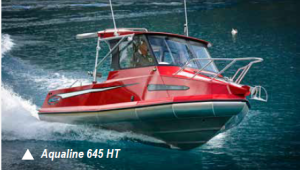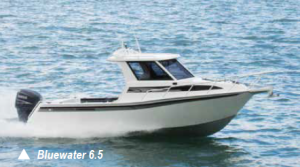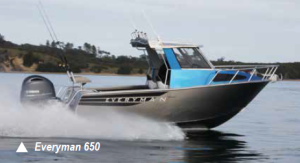We look at some of the more popular cabin and hardtop production boats around 6.5m.
The aluminium boat market is dominated by mid-size cabin and hardtop models, with most manufacturers offering a boat in ‘6m-6.7m size bracket. This may vary by a few centimetres either way, but then what’s a little length between friends. Well, you might be surprised, as what is given as the model name, i.e. 650, may not mean what you think. First impression is the boat is 6.5m overall, but is the hull length (LOH) from transom to bow or is that the overall length (LOA) from the back of the engine pod to the tip of the bowsprit. This can make a huge difference to the true hull length and may be as much as half a metre, so it pays to do your homework and check it out.
The LOA is an important consideration when you are thinking of where you are going to store the boat. However don’t forget to add on the extra length of the outboard and the drawbar. Again this can be well over 1m and may require you to have a hinged drawbar. This is a simple way to shorten the length of your rig, so the hinge is virtually directly below the bow. To make the outboard ‘shorter’ tilting it down and over to one side will save you a bit more space.
The LOH is a measurement that in the end determines just how much ‘boat’ you have and this is where the variants show. While size is a factor, there are a lot of other things you need to consider before paying out the money for your boat.
Open or Closed
In the mid range category, there are two main options; hardtop or cabin. While open runabouts are also available, they are certainly not as popular. If you are looking for all weather protection and plan to do your fishing all year round then the hardtop option is certainly the best.
A hardtop gives you cover from good weather and bad. Nothing is worse than too much sun or too much rain. Hardtops have solid glass forward screens so you can fit windscreen wipers, which are a great addition when driving the boat in wet conditions. Side windows are either fixed or sliding and the hardtop allows you somewhere to
mount your electronics such as the radar dome, GPS and aerials, plus a rocket launcher for the rods.
Although it is more common on boats under 6.5m to have no rear bulkhead, so the hardtop is only semi-enclosed with three sides, you can also have a rear bulkhead with a door if you want a totally enclosed wheelhouse style hardtop. This limits your seating options due to space constraints, but it does give you awesome all-weather
protection and a big, uninterrupted fishing cockpit.
With a hardtop, be it enclosed or semi-enclosed you also have a better safeguard for your electronics against water. Instruments and electronics today are not as sensitive to salt water as they used to be, but your iPhone, iPad or electronic car keys are.
They are also good when overnighting, as you can be completely enclosed and comfortable out of the weather. It is not uncommon to have a small galley and fridge units built in under the seats and a head (either portable or plumbed in) under the forward v-berth.
If you still like the feel of the open air, then the standard cabin style, with a rocket launcher and soft bimini with clears is the way to go. Depending on how good the canopy is, you can get very well protect ted from the weather, and the rocket launcher is normally far even forward, so it doesn’t encroach into your fishing space. In both styles, you can mount a cockpit floodlight, which is great if you are into late evening or night fishing.
Usability
The first step to determining which boat is right for you is deciding where you will be using your boat the most. Making this decision will help you zero in on the perfect aluminium boat for your personal use, all while giving you a firmer grasp of what types of boats are out there and how much you can expect to pay.
However in the case of an aluminium trailer boat in the mid range, its odds on that you want it primarily for fishing. If that’s the case, then what sort of fishing and where? If you are planning top predominantly troll for trout on Lake Taupo or Lake Wanaka, then a big open hardtop with plenty of forward seating and coverage from the sun or rain would be most suitable.
Conversely, if you are an offshore fisherman, that likes to go ‘wide’ then an enclosed hardtop with an emphasis on fishing space and associated amenities is going to work better.
Aqualine 645 HT
The layout of the forward section of either design will have a v-berth in the cabin, a matching pair of helm and passenger seats (with a king/queen option on the semienclosed designs) and optional aft jump seats. These come in a variety of styles, from sliding bench seats as found in boats from Aqualine and Kiwi Kraft to fold down rear bench seats that stow away unnoticed into the transom, such as on the latest McLay Premier series.

If you are fishing a lot, then the last things you want are seats getting in your space, so it’s important that these are out of the way or able to be removed when not required.
Transom designs are another space that comes in a lot of variables and it is important to check out what the boat you are looking at has. Firstly you need a good mount for the bait board and also make sure the bait board is of a generous size and good solid design.
Often these are detachable and mount in the same hole as the ski pole, so you can tow your kids on water toys between fishing trips if you need too. Aluminium boats can easily be customised, especially around the transom spaces, so wide transom step through, live bait tanks, tuna tubes, kill tanks and fresh/salt water wash-downs should all be considered.
If you are into diving, then a good size boarding platform is a bonus, especially with a step through that is wide enough to sit in with all your gear on, a wide tread drop down ladder and a reasonable handrail to assist when getting back aboard.
Storage is something else to look at when buying a boat and while most boat’s come with wide side shelves and under-floor lockers, it’s not always the case. Some pontoon boats have limited availability for side shelves. A big underfloor wet locker just aft of the underfloor fuel is common in most boats, with the side areas sealed buoyancy.
Maintenance Needs
If you are hoping for a boat that more or less maintains itself, your aluminium boat shopping experience will likely disappoint you. Where you live and what type of water you plan to use your boat in will decide largely what is required of you, as far as routine maintenance is concerned. No boat exists that requires no attention and still remain in tip-top shape.
Without the proper care, a boat can be damaged simply being exposed to salt water, be it unsightly staining or something more serious and structural. Saltwater is especially corrosive to aluminium and needs to be fresh water washed every time it is used in salt water. It doesn’t take long to give the boat a good hose-off, both the cockpit and the hull. Salt should not be allowed to stay on your boat’s hull when it comes out of the water, as it will cause stains or even eat through the metal.
Today, alloy boat manufacturers use the better grades of marine alloys that have high corrosive inhibitors, but even then they still need to be washed clean of any salt. Boats in this category are almost always 4mm or 5mm hulls with 3mm sides and superstructures. Long underfloor beams and cross stringers with a welded sole stiffen everything up, so they don’t rattle like they used to.
Similarly, freshwater boats will have to deal with algae stains or growths. In general, algae are less damaging to aluminium boats than salt water is, but both substances can tarnish an otherwise beautiful piece of watercraft.
Hull Design

Of the boats in our attached listing, there are two distinct designs; the conventional medium vee monohull and the hugely popular ‘Kiwi’ inspired pontoon boat. The pontoon boat, while still running a vee bottom hull from the chines to the keel is quite different between the chines and the gunnel. This worldwide revolution was started in Invercargill by Stabi Craft Boats and now accounts for a major proportion of alloy trailer boat sales in New Zealand.
Interestingly the Australian alloy boat manufacturers have been somewhat slower to accept the pontoon style, with no Australian manufacturers and virtually all sales coming from Kiwi builders. Unquestionably, New Zealand leads the world in this style of boat design and manufacture.
When it comes to ride and handling of all the different options, there is not a huge difference. While some perform a little better than others in rougher water, in the following or head sea or on mirrorsmooth waters, the running surfaces is not that much different.
A 6.5m boat has around 2.5m beam at the chines, a deadrise of 18-20 deg at the stern and a variable increasing deadrise going forward to a fine forward entry. Where the differences are made is in the position, shape, angle and width of the chines and strakes. If the manufacturers fill the under floor cavities with foam for buoyancy reasons, then you have the bonus of a natural sound deadening material so the traditional “alloy slap” can be decreased dramatically.

Power
A 6m-6.7m boat, no matter what the design is ideally suited to 130- 175hp. More is okay and 6.5m boats will easily handle up to 225hp and a 6m boat will run okay with 115hp. What power you bolt on the transom is really up to you as you determine what you need the power for.
If you are trolling a lot, then a four stroke at the lower end of the horsepower scale is going to be fine. However, if you’re an offshore fisherman and need plenty of power to get to your fishing spot or beating the bad weather on the trip home, then go to the top end of power range.
Interestingly most manufacturers now offer the same engine in a variety of power variants, so the only difference is the size of the chip and the amount of fuel being sent through the injectors. Weight wise a 150hp outboard may well be the same as a 200hp, so you might as well go for the higher option and you have the power if you need it.
When it comes to power, there is also a move towards small diesel sterndrive engine packages in boats up to and around 6.5m and these give you another very economical alternative. In most cases, manufacturers utilise the extra space in the stern taken up by the engine box to provide extra seating or a fishing station, so there are some extra benefits.
Your Choice
So what boat do you choose? That is entirely up to you, but as a guide, you should do your homework first. Ask someone who owns a particular model what they think. There is nothing better than firsthand experience from an end user who has had time to evaluate the boat and find out the good and bad points.
Read boat tests for unbiased and informed reports from magazines and check out social media such as You Tube and Face Book for what people are saying about a particular brand.
It is also ideal to purchase the total rig; boat, motor, trailer and all the extras from one dealer, so you always have the recourse of going back if there is a problem. Buying local certainly makes it a lot easier when you need to take it in for a service or some other issues. They will also set up the boat with knowledge on engine heights and propeller selection and take a lot of the guesswork out of the buying decision. If you haven’t got an outboard brand preference, then be advised by the dealer as they have the experience to match the right engine for the right boat. Today, the ranges of engines from all major manufacturers are very good, reliable and trouble free. New 4 strokes and direct injection 2-strokes are becoming incredibly fuel efficient, which makes your time on the water even better.
Buying a new boat can be a very emotional experience and it’s important to make sure you get the right one for your needs.




